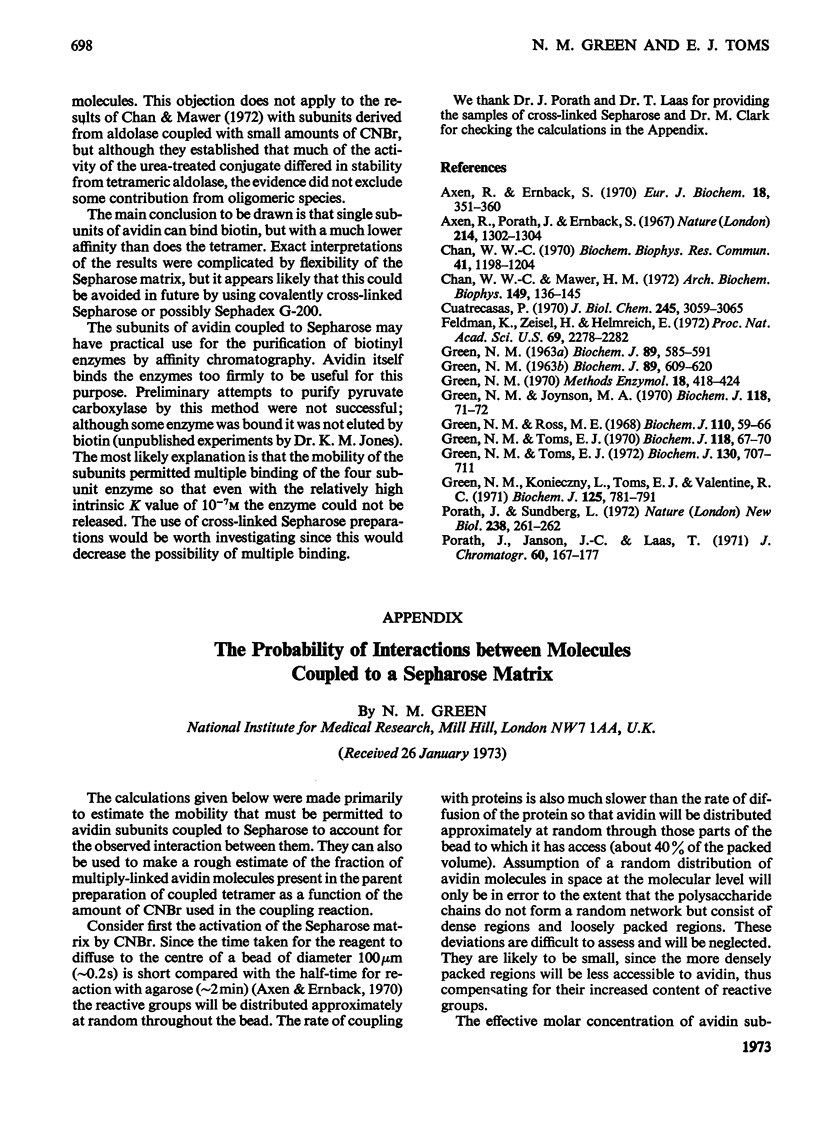Abstract
Avidin that had been coupled to Sepharose 4B activated with CNBr retained over 90% of its biotin-binding capacity. When low concentrations of CNBr were used about 75% of the protein could be removed from the Sepharose by washing with guanidinium chloride (6 m). The remaining 25%, the covalently bound subunits, had an almost undiminished capacity for biotin but a decreased affinity. Addition of avidin subunits in guanidinium chloride to the coupled subunits followed by dilution or dialysis restored the original biotin-binding capacity and affinity. Three classes of binding sites were present in preparations of the subunits. About 25% were weak (K=5×10−8m), about one third exchanged their biotin in a few minutes (K∼10−10m) and the remainder were indistinguishable from the native tetramer. The last-named exchanged their bound biotin at a similar rate at pH5 and at pH2, they did not lose their biotin in 6 m-guanidinium chloride and they were resistant to tryptic digestion in the absence of biotin. The proportion of these stable sites could be increased to 65% when the subunits coupled to Sepharose were incubated at 37°C. This increase was reversed by guanidinium chloride, which suggested that it was caused by a temperature-dependent association of covalently linked subunits. This in turn implies a temperature-dependent mobility of the agarose matrix of the Sepharose. Analysis of the spatial distribution of subunits within the Sepharose beads led to the conclusion that the association of subunits implied that they could move through distances greater than 20nm (several hundred Å). This mobility and consequent formation of tetramer was greatly decreased when avidin subunits were coupled to Sepharose that had been cross-linked with divinyl sulphone.
Full text
PDF











Selected References
These references are in PubMed. This may not be the complete list of references from this article.
- Axén R., Ernback S. Chemical fixation of enzymes to cyanogen halide activated polysaccharide carriers. Eur J Biochem. 1971 Feb 1;18(3):351–360. doi: 10.1111/j.1432-1033.1971.tb01250.x. [DOI] [PubMed] [Google Scholar]
- Axén R., Porath J., Ernback S. Chemical coupling of peptides and proteins to polysaccharides by means of cyanogen halides. Nature. 1967 Jun 24;214(5095):1302–1304. doi: 10.1038/2141302a0. [DOI] [PubMed] [Google Scholar]
- Chan W. W. Matrix-bound protein subunits. Biochem Biophys Res Commun. 1970 Dec 9;41(5):1198–1204. doi: 10.1016/0006-291x(70)90213-5. [DOI] [PubMed] [Google Scholar]
- Chan W. W., Mawer H. M. Studies on protein subunits. II. Preparation and properties of active subunits of aldolase bound to a matrix. Arch Biochem Biophys. 1972 Mar;149(1):136–145. doi: 10.1016/0003-9861(72)90307-4. [DOI] [PubMed] [Google Scholar]
- Cuatrecasas P. Protein purification by affinity chromatography. Derivatizations of agarose and polyacrylamide beads. J Biol Chem. 1970 Jun;245(12):3059–3065. [PubMed] [Google Scholar]
- Feldmann K., Zeisel H., Helmreich E. Interactions between native and chemically modified subunits of matrix-bound glycogen phosphorylase. Proc Natl Acad Sci U S A. 1972 Aug;69(8):2278–2282. doi: 10.1073/pnas.69.8.2278. [DOI] [PMC free article] [PubMed] [Google Scholar]
- GREEN N. M. AVIDIN. 1. THE USE OF (14-C)BIOTIN FOR KINETIC STUDIES AND FOR ASSAY. Biochem J. 1963 Dec;89:585–591. doi: 10.1042/bj0890585. [DOI] [PMC free article] [PubMed] [Google Scholar]
- GREEN N. M. AVIDIN. 4. STABILITY AT EXTREMES OF PH AND DISSOCIATION INTO SUB-UNITS BY GUANIDINE HYDROCHLORIDE. Biochem J. 1963 Dec;89:609–620. doi: 10.1042/bj0890609. [DOI] [PMC free article] [PubMed] [Google Scholar]
- Green N. M., Joynson M. A. A preliminary crystallographic investigation of avidin. Biochem J. 1970 Jun;118(1):71–72. doi: 10.1042/bj1180071. [DOI] [PMC free article] [PubMed] [Google Scholar]
- Green N. M., Konieczny L., Toms E. J., Valentine R. C. The use of bifunctional biotinyl compounds to determine the arrangement of subunits in avidin. Biochem J. 1971 Dec;125(3):781–791. doi: 10.1042/bj1250781. [DOI] [PMC free article] [PubMed] [Google Scholar]
- Green N. M., Ross M. E. The effect of N-bromosuccinimide on the sub-unit structure of acidin and its complexes with biotin. Biochem J. 1968 Nov;110(1):59–66. doi: 10.1042/bj1100059. [DOI] [PMC free article] [PubMed] [Google Scholar]
- Green N. M., Toms E. J. Purification and crystallization of avidin. Biochem J. 1970 Jun;118(1):67–70. doi: 10.1042/bj1180067. [DOI] [PMC free article] [PubMed] [Google Scholar]
- Green N. M., Toms E. J. The dissociation of avidin-biotin complexes by guanidinium chloride. Biochem J. 1972 Dec;130(3):707–711. doi: 10.1042/bj1300707. [DOI] [PMC free article] [PubMed] [Google Scholar]
- Porath J., Sundberg L. High capacity chemisorbents for protein immobilization. Nat New Biol. 1972 Aug 30;238(87):261–262. doi: 10.1038/newbio238261a0. [DOI] [PubMed] [Google Scholar]


